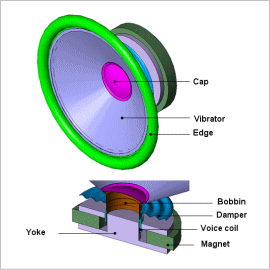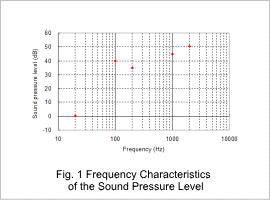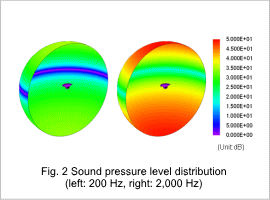*Please prepare a license ID and password for the license administrator.
*It is different from the service for JMAG WEB MEMBER (free membership). Please be careful.
Overview

A loudspeaker produces sound when the voice coil makes the vibrator vibrate. The general requirement of the loudspeaker is to produce uniform sound over a wide range of the frequencies.
Lorentz force is generated in the coil when the magnetic field of a permanent magnet acts on the current flowing through the voice coil, and produces sound by making the vibrator vibrate. In order to evaluate the sound with good accuracy, it is necessary to handle the resonance phenomenon between the Lorentz force and the speaker’s eigenmode properly. The eigenmode and Lorentz force distribution change depending on the place where the core and coil are wound, so high accuracy calculations need to be carried out using the finite element method (FEM).
This Application Note presents how the frequency characteristics of sound pressure can be obtained using the constant Lorenz force on the voice coil, regardless of the frequency.
Lorentz force is generated in the coil when the magnetic field of a permanent magnet acts on the current flowing through the voice coil, and produces sound by making the vibrator vibrate. In order to evaluate the sound with good accuracy, it is necessary to handle the resonance phenomenon between the Lorentz force and the speaker’s eigenmode properly. The eigenmode and Lorentz force distribution change depending on the place where the core and coil are wound, so high accuracy calculations need to be carried out using the finite element method (FEM).
This Application Note presents how the frequency characteristics of sound pressure can be obtained using the constant Lorenz force on the voice coil, regardless of the frequency.
Sound Pressure Level
The frequency characteristic of the sound pressure level at the front center of the loudspeaker is shown in fig. 1. The sound pressure distributions at frequencies of 200 Hz and 2000 Hz are shown in fig. 2.
It becomes apparent from the frequency characteristics of the sound pressure level that this speaker is able to obtain a fairly uniform output at over 100 Hz, and that it is not suited to usage in the low frequency region of below 100 Hz.




